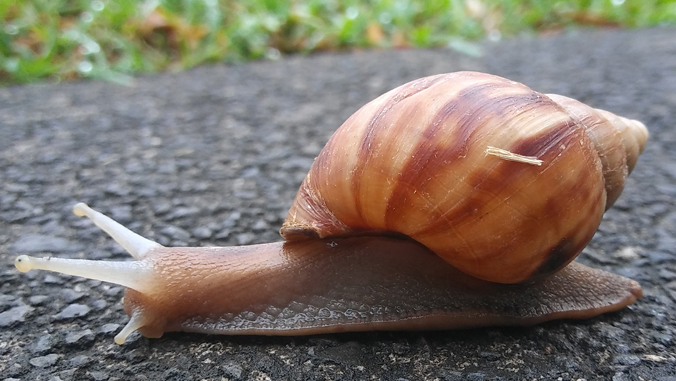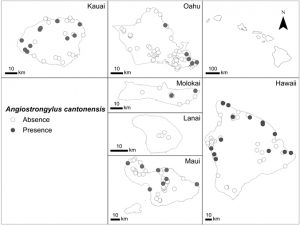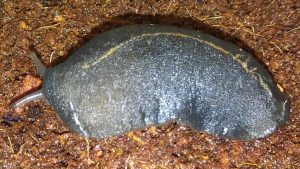
A University of Hawaiʻi at Mānoa study reveals that Angiostrongylus cantonensis or rat lungworm is widespread in the Hawaiian Islands, and its distribution may expand, especially toward higher elevations as the climate warms.
Rat lungworm is a parasitic nematode with a complicated life cycle, part of which requires living inside snails and slugs. Human infection by this parasite is considered an emerging infectious disease. The range and incidence of the disease are expanding throughout the tropics and subtropics, including in the Hawaiian Islands, making this work especially timely.
Using molecular techniques to screen almost 1,300 snails and slugs representing 37 species from almost 200 sites across the Hawaiian Islands, the team determined rat lungworm was present in numerous species of snails and slugs on five of the six largest islands (it may be present on all islands but just not detected). Further, rat lungworm tended to occur in warmer and rainier locations generally, but not exclusively, windward.
Knowledge of where rat lungworm is or could be across the Hawaiian Islands is important from the perspective of prevention of human and animal infection.
“Local residents and visitors need to know what the risks are. The data will be important to the state Department of Health in targeting epidemiological surveys and interventions,” said Robert Cowie, senior author on the study and a research professor at the UH Mānoa Pacific Biosciences Research Center in the School of Ocean and Earth Science and Technology. “Also, remember that it is not possible to say that rat lungworm is absent from locations where we did not detect it. One can never do a totally comprehensive survey of all snails present in Hawaiʻi, so people must not be complacent and assume, for instance, that based on this study rat lungworm is not in their yards.”
Rat lungworm predicted to expand to higher elevations

By assessing factors affecting the parasite’s distribution, the study projected its potential future distribution in Hawaiʻi, with implications for its global expansion. The team developed mathematical models that allowed a prediction of the likely areas across the islands where rat lungworm could occur, if it is not there already, and projected its distribution based on anticipated climate conditions in the year 2100.
Under these future climate conditions, rat lungworm was predicted to expand its range to higher elevations in Hawaiʻi. The findings imply that the parasite could also expand its primarily tropical and subtropical range globally to regions that are currently more temperate.
“From a global perspective, the knowledge of where rat lungworm is or could be present currently, combined with our projections of its future potential distribution have implications for the future spread of rat lungworm disease,” said Cowie. “Rat lungworm disease has been considered globally as a neglected but emerging infectious disease.”
Added Jaynee Kim, lead author on the study as a UH graduate student and now a malacology researcher at Bishop Museum, “A major motivation for my research was to help people to make informed decisions. We encourage the public to buy local and support Hawaiʻi‘s economy but, at the same time, to be vigilant about washing produce, especially to inspect and wash greens leaf by leaf. Buying and planting native plants instead of non-native plants can also help keep invasive snail hosts from being introduced and spread throughout the islands.”
—By Marcie Grabowski



